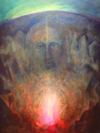The Wedding Garment
The Wedding Garment (Matt.22:1-14)
In our time, many people are living in the illusion that they can step into heaven just as they have lived on earth—straight up to God to tell him that things are not right on earth, and that He has to do something to put them in order.
Long ago, there was a time when people said when fate had struck: “The Lord has given, the Lord has taken away. Praised be the Name of the Lord!” Thereafter it became quiet, and people began to have doubts about the omnipotence of God. And now? It is only a relatively short time ago that people dared to ask: “Where is God in all those places where life has turned into hell? Why doesn’t He show His omnipotence?” In all questions of this sort sounds a still or loud reproach. We do not want to change ourselves; God has to do it for us.
When we want to ask God a question, we cannot simply stay the way we are. In the words of Christ: “…whoever does not take up the Kingdom of God in himself like a child, he will not find access to it” (Mk.10:15). When we want to enter His realm, we have to leave behind all that binds us to the dying earth existence: our possessions, our affairs, our everyday habits, our judgments and prejudices. We have to become like new-born children. We can stand before God only when we take our shoes off our feet, when we put away our outer confidence, when we want to receive the white garment of His pure life from His hands. Then we are ready to enter the wedding hall and stand eye to eye before Him.
–Rev. Bastiaan Baan 10/4/2020

